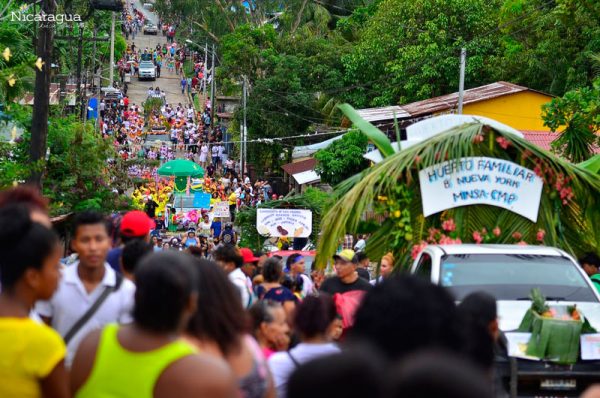May is without a doubt
the most movable month on the Caribbean coast of Nicaragua, a time to celebrate
the ancestral roots of the Nicaribbean people and to thank nature for its
heavenly waters that heal, bless and multiply the harvests.
It is a time to dance
Maypole, a tradition that has transcended from one continent to another, which
purpose has not changed at all: to thank the earth, and celebrate fertility and
the harvest.
Learn about this
tradition of the Afrodescendant people of Nicaragua’s Caribbean Coast.

Origin
According to historical
text, the concept of Maypole originated in Egypt, but it arrived at the
Caribbean coast of Nicaragua from Europe, specifically from England, during the
time of the British occupation of this territory in the Americas.
It originated from
practices of ancient civilizations that celebrate the goddess of fertility,
which, in this case, for the Egyptians was the Isis; while, in other
civilizations such as the Greeks and Romans, they referred to her by the name
of Maia.
Germanic countries such
as Deutschland, Sweden, Belgium, Holland, and England also used to worship
under the same concept using a tree that was decorated with flowers and
colorful ribbons, this was known as the spring ritual.
In England, on the
first of May, it is common to celebrate –especially in small villages– May Day,
a feast to welcome summer and that unites people of all ages. Locals will
usually dance around a dry tree trunk decorated with colored ribbons and
flowers.
The arrival of Maypole in Nicaragua
It arrived in Nicaragua
when the English occupied the Caribbean Coast around the 17th century. It is
not known exactly what date it was, but historians affirm that the celebration
as we know it today was brought from Jamaica, since at that time it was the
main colony of the English Empire in the Caribbean.
After reaching the
Caribbean from Europe, this celebration evolved, because it was combined with
the rhythms of this region and of the Africans who were brought as slaves to
these lands. The flora, the weather, and the multiple customs, mainly of the
Africans, merged, giving another twist to the European Maypole, creating a
whole new version of this celebration.
In the Caribbean,
people dance Maypole to celebrate the arrival of the rainy season and to thank
Mother Nature for the fruits of the season.

Mayo Ya
In Nicaragua the name of this celebration is Mayo Ya, this is because right after the triumph of the Sandinista Revolution, the government decided in 1980 that Maypole should be a festivity for all the indigenous and ethnic groups of the Caribbean, as well as of Nicaragua, since it was only celebrated in black creole communities like Bluefields, Pearl Lagoon, Corn Island and Bragman’s Bluff—Puerto Cabezas.
That same year (1980) the ingenious phrase or connotation —Mayo Ya— was born, which, in other words, could be said to mean that “the Maypole belongs to everyone, and it is now”. The one who baptized the May festivities in Nicaragua with this name was the Afronicaraguan poet and writer, Carlos Rigby.

Rhythms and music
The original Maypole of the Caribbean carries rhythms based on rustic instruments, such as a coconut grater, donkey jawbone, tortoiseshell, washing tub, hand drums, and maracas, as well as guitar, banjo, accordion, and violin. The genre of the traditional Maypole music is calypso and soca, very popular in the English-speaking islands of the Greater Caribbean.
Some traditional songs are Sing Simon Sing My Love, Mayaya Lost His Key, Launch Turn Over, Come Down Breda Willy, among others. Many of the Maypole songs are testimonials and were made to denounce the injustices that occurred in the communities of the South Caribbean at that time.

Some Maypole celebration customs
Previously in the
Creole communities, on the first of May when the Maypole celebrations began,
they would have different games while singing songs such as Brown girl in the
ring, London Bridge is falling down and Down on the carpet. These songs are of
British origin.
Food is quite common in
this celebration, dishes such as rice and beans made out of coconut milk, soda
cake, patty, bun, and ginger beer are usually savored during the Maypole
gathering.
As for the celebration
dates, it is traditionally held every weekend in a different neighborhood,
where the residents of other vicinities will gather to dance and enjoy.
Maypole is held
basically throughout the whole Caribbean Coast and in some cities of the
Pacific region of Nicaragua, and although today it is not celebrated with the
pagan beliefs it was originated with, locals still dance to the sound of
traditional music around the Maypole tree to thank Mother Nature for the first
raindrops and for the harvest.


